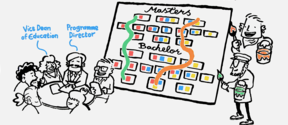The university's language guidelines abide by the following principles:
- Multiculturalism and multilingualism are seen as assets.
- All should feel welcome as members of the community.
- Everyone may participate as a full member of the community.
- Finnish, Swedish and English are used in parallel as suitable to the purpose.
- In a learning-centered culture, everyone has room to develop as a communicator.
International, multicultural and inclusive Aalto University
1) A multilingual and inclusive culture
- Aalto University encourages linguistic diversity and the parallel use of languages within the community.
- We are developing our ways of working and supporting the work communities in developing practices to increase language awareness.
- The various university bodies, groups and committees use the working languages flexibly, making sure that all members have equal opportunities to participate in discussion.
- Aalto University supports the integration of international students and staff and offers them the possibility to study Finnish culture.
- Students and staff are encouraged to study Finnish, Swedish and English.
- Aalto University provides the prerequisites for inclusive and high-quality cooperation and communication.
- Staff are encouraged to develop their competencies in inclusive language and communication.
2) Research
- Research publications characterised by fluent and consistent language are an important part of academic quality.
- In the global scientific and artistic community, we work mainly in English. We develop scientific terminology in Finnish and Swedish in collaborative networks. Through science communication in Finnish or Swedish, we promote societal impact within Finland.
3) Languages of degree and instruction
4) Services
- Aalto University's working languages are Finnish, Swedish and English. We encourage the parallel use of the three languages as suitable to the purpose.
- The key documents concerning education are available in Finnish, Swedish and English. Internal documents, forms, decisions and instructions are available mainly in Finnish and English.
- Key terms are used consistently.
- University documents are written fluently and clearly. Editing, translation and proofreading services may be utilised to ensure this quality.
5) Communications
- Communications are conducted with an awareness of the situation, the communications channel and the language(s) best suited to serve the intended audience.
- The Aalto University website aalto.fi is published and maintained in Finnish, English and partly in Swedish.
Implementation of multilingualism and inclusivity at Aalto University
- The university's way of working and development practices emphasise proactiveness as well as the participation and engagement of the university community.
- Each member of the Aalto University community has an opportunity and a responsibility to foster a culture of linguistic diversity and inclusivity at the university.
- The implementation plan will provide a more detailed description of how the language guidelines will be put into action.
- Implementation follow-up will be integrated into the management processes; these are defined in the annual clock, which describes Aalto's strategic processes.
- The university’s development work in this area is the responsibility of the provost, who is supported in this task by the university's equality, diversity and inclusion officer (EDI officer) and the EDI committee. The implementation of the measures at the individual schools is the responsibility of the school deans, supported in this task by the development manager (or equivalent person in charge) and the EDI group of the school. University services are responsible for implementing the agreed-upon measures and supporting their execution in their respective service areas.




